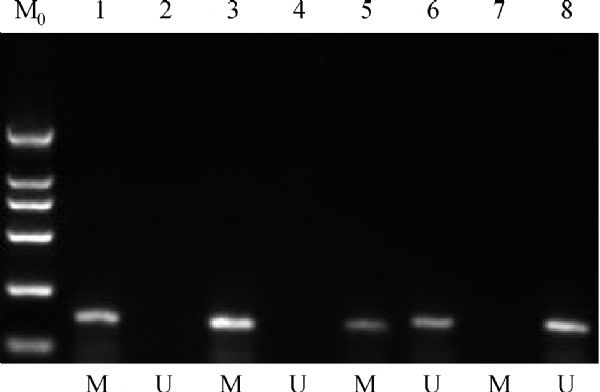

Effects of hydralazine and valproate on the expression of E-cadherin gene and the invasiveness of QBC939 Cells
Received date: 10 Oct 2008
Accepted date: 12 Dec 2008
Published date: 05 Jun 2009
Copyright
To clarify the effect of DNA methylation and histone deacetylase inhibitors on the expression of the E-cadherin gene and the invasiveness of the QBC939 cells, the QBC939 cells were separately treated with hydralazine, valproate, or combination of the two drugs. The mRNA expression of E-cadherin was examined with reverse transcription-polymerase chain reaction (RT-PCR), the protein of the gene with Western blotting. The methylation status of the promoter region of the gene was detected with methylation-specific PCR (MSP). The invasiveness of QBC939 cells was detected with transwell assay. It was found that the promoter region of the E-cadherin gene of QBC939 cells was hypermethylated. Valproate alone could not contribute to demethylation of the gene, whereas hydralazine could make them to be partly demethylated. However, the methylation status of the gene could be thoroughly reversed by using valproate and hydralazine in combination. What’s more, it was confirmed that the E-cadherin gene of QBC939 cells could not be transcriptionally reactivated by Valproate alone, whereas hydralazine alone could induce moderate reexpression of the gene. However, using valproate and hydralazine in combination could result in robust reexpression of the E-cadherin gene (P=0.000). Likewise, the invasiveness of the QBC939 cells was sharply decreased by treatment with two drugs in combination and slightly decreased with one drug alone. It could be concluded that the two drugs have synergistic effect on the demethylation and reexpression of the E-cadherin gene of QBC939 cells, and also on the reduction of the invasiveness of the QBC939 cells.

Hong LI , Shaoqin CHEN , Yi SHU , Yongjun CHEN , Ying SU , Xin WANG , Shengquan ZOU . Effects of hydralazine and valproate on the expression of E-cadherin gene and the invasiveness of QBC939 Cells[J]. Frontiers of Medicine, 2009 , 3(2) : 153 -157 . DOI: 10.1007/s11684-009-0034-5
| 1 |
BirchmeievW,BehrensJ.Cadherin expression in carcinomas: role of the formation of cell junction and the prevention of invasiveness.Biochim Biophys Acta, 1994, 1198(1): 11-26
|
| 2 |
LiottaL A,SteegP S,Stetler-StevensonW G.Cancer metastasis and angiogenesis: an imbalance of positive and negative regulation. Cell, 1991, 64(2): 327-336
|
| 3 |
MareelM,BrackeM,Van RoyF. Cancer metastasis: negative regulation by an invasion-suppressor complex. Cancer Detect Prev, 1995, 19(5):451-464
|
| 4 |
BerxG,Van RoyF.The E-cenhaoadherin/catenin complex: an important gatekeeper in breast cancer tumorigenesis and malignant progression. Breast Cancer Res, 2001,3(5): 289-293
|
| 5 |
LiQ,WangJ M,LiuC,XiaoB L,SuY,ZouS Q.Expression and significance of aPKC-ι and E-cadherin in Cholangiocarcinoma. Ai Zheng, 2007, 26(7): 715-718 (in Chinese)
|
| 6 |
TamuraG,YinJ,WangS,FleisherA S,ZouT,AbrahamJ M,KongD,SmolinskiK N, WilsonK T,JamesS P,SilverbergS G,NishizukaS,TerashimaM,MotoyamaT,MeltzerS J. E-Cadherin gene promoter hypermethylation in primary human gastric carcinomas.J Natl Cancer Inst, 2000, 92(7): 569-573
|
| 7 |
Zöchbauer-MüllerS,FongK M,VirmaniA K,GeradtsJ,GazdarA F,MinnaJ D.Aberrant promoter methylation of multiple genes in non-small cell lung cancers. Cancer Res, 2001, 61(1): 249-255
|
| 8 |
YangB,HouseM G,GuoM,HermanJ G,ClarkD P.Promoter methylation profiles of tumor suppressor genes in intrahepatic and extrahepatic cholangiocarcinoma. Mod Pathol, 2005, 18(3): 412-420
|
| 9 |
JonesP A,BaylinS B.The fundamental role of epigenetic events in cancer. Nat Rev Genet, 2002,3(6): 415-428
|
| 10 |
ZhuW G,OttersonG A.The interaction of histone deacetylase inhibitors and DNA methyltransferase inhibitors in the treatment of human cancer cells. Curr Med Chem Anti-Cancer Agents, 2003,3(3): 187-199
|
| 11 |
de la Cruz-HernándezE,Pérez-CárdenasE,Contreras-ParedesA,CantúD,MoharA,LizanoM,Dueñas-GonzálezA.The effects of DNA methylation and histone deacetylase inhibitors on human papillomavirus early gene expression in cervical cancer, an in vitro and clinical study.Virol J, 2007, 4: 18
|
| 12 |
HermanJ G,GraffJ R,MyohanenS,NelkinB D,BaylinS B.Methylation-specific PCR: a novel PCR assay for methylation status of CpG islands.Proc Natl Acad Sci U S A, 1996, 93(18): 9821-9826
|
| 13 |
YapA S,BrieherW M,GumbinerB M.Molecular and functional analysis of cadherin-based adherens junctions.Annu Rev Cell Dev Biol, 1997, 13: 119-146
|
| 14 |
MikamiT,SaegusaM,MitomiH,YanaqisawaN,IchinoeM,OkayasuI.Significant Correlations of E-Cadherin, Catenin, and CD44 Variant Form Expression With Carcinoma Cell Differentiation and Prognosis of Extrahepatic Bile Duct Carcinomas.Am J Clin Pathol, 2001, 116(3): 369-376
|
| 15 |
JooY E,RewJ S,ParkC S,KimS J.Expression of E-cadherin, alpha- and beta-catenins in patients with pancreatic adenocarcinoma.Pancreatology,2002,2(2): 129-137
|
| 16 |
BerxG,Cleton-JansenA M,NolletF,de LeeuwW J,van de VijverM,Cornelisse,C,van RoyF. E-cadherin is a tumour/invasion suppressor gene mutated in human lobular breast cancers. EMBO J, 1995, 14(24): 6107-6115
|
| 17 |
VleminckxK,VakaetL Jr,MareelM,FiersW,vanRoy F.Genetic manipulation of E-cadherin expression by epithelial tumor cells reveals an invasion suppressor role. Cell, 1991, 66(1):107-119
|
| 18 |
AsayamaY,TaguchiKi K,AishimaSi S,NishiH,MasudaK,TsuneyoshiM.The mode of tumour progression in combined hepatocellular carcinoma and cholangiocarcinoma: an immunohistochemical analysis of E-cadherin, alpha-catenin and beta-catenin.Liver, 2002,22(1): 43-50
|
| 19 |
SharmaD,BlumJ,YangX,BeaulieuN,MacleodA R,DavidsonN E.Release of methyl CpG binding proteins and histone deacetylase 1 from the Estrogen receptor alpha (ER) promoter upon reactivation in ER-negative human breast cancer cells. Mol Endocrinol, 2005,19(7): 1740-1751
|
/
| 〈 |
|
〉 |